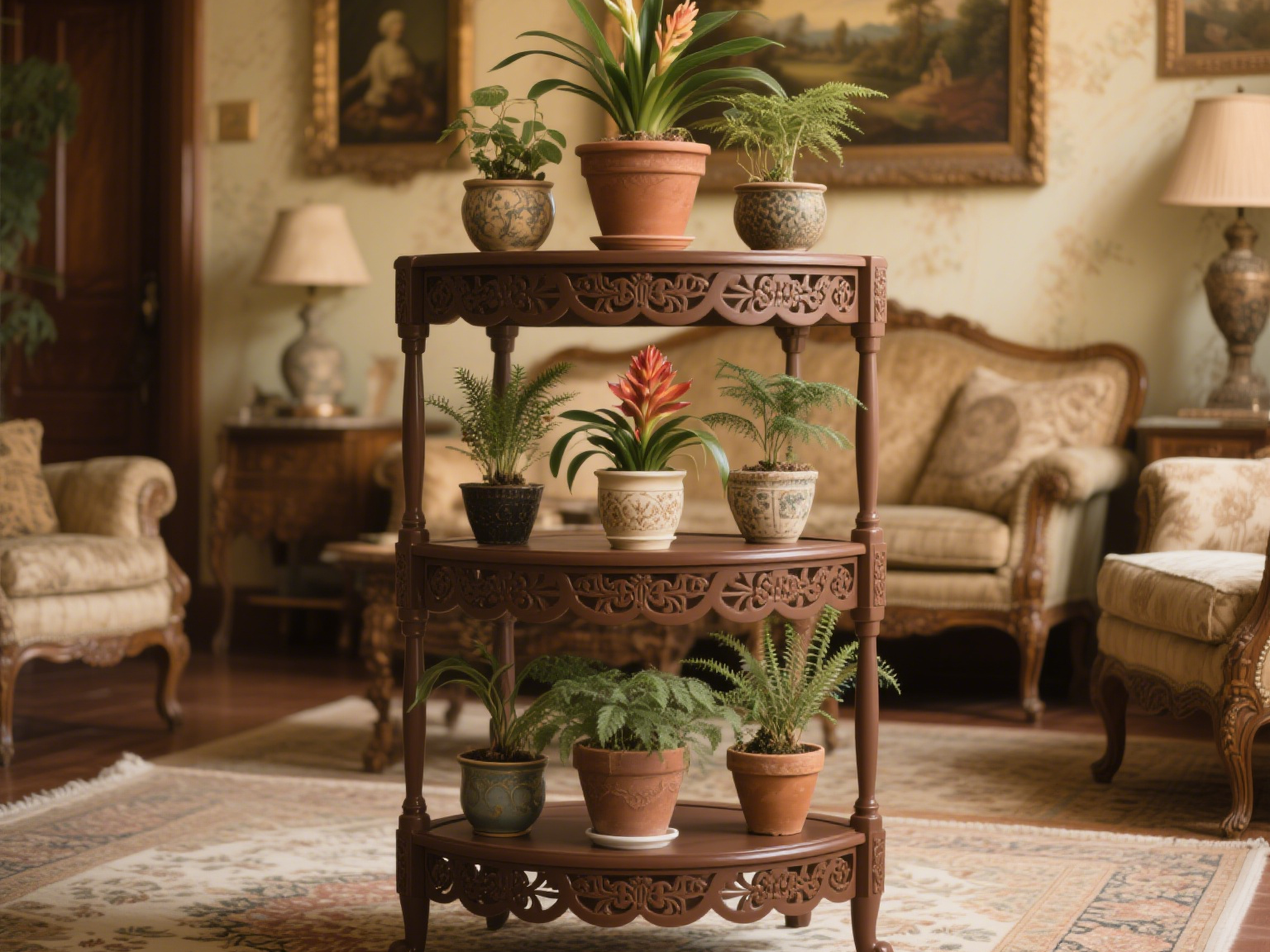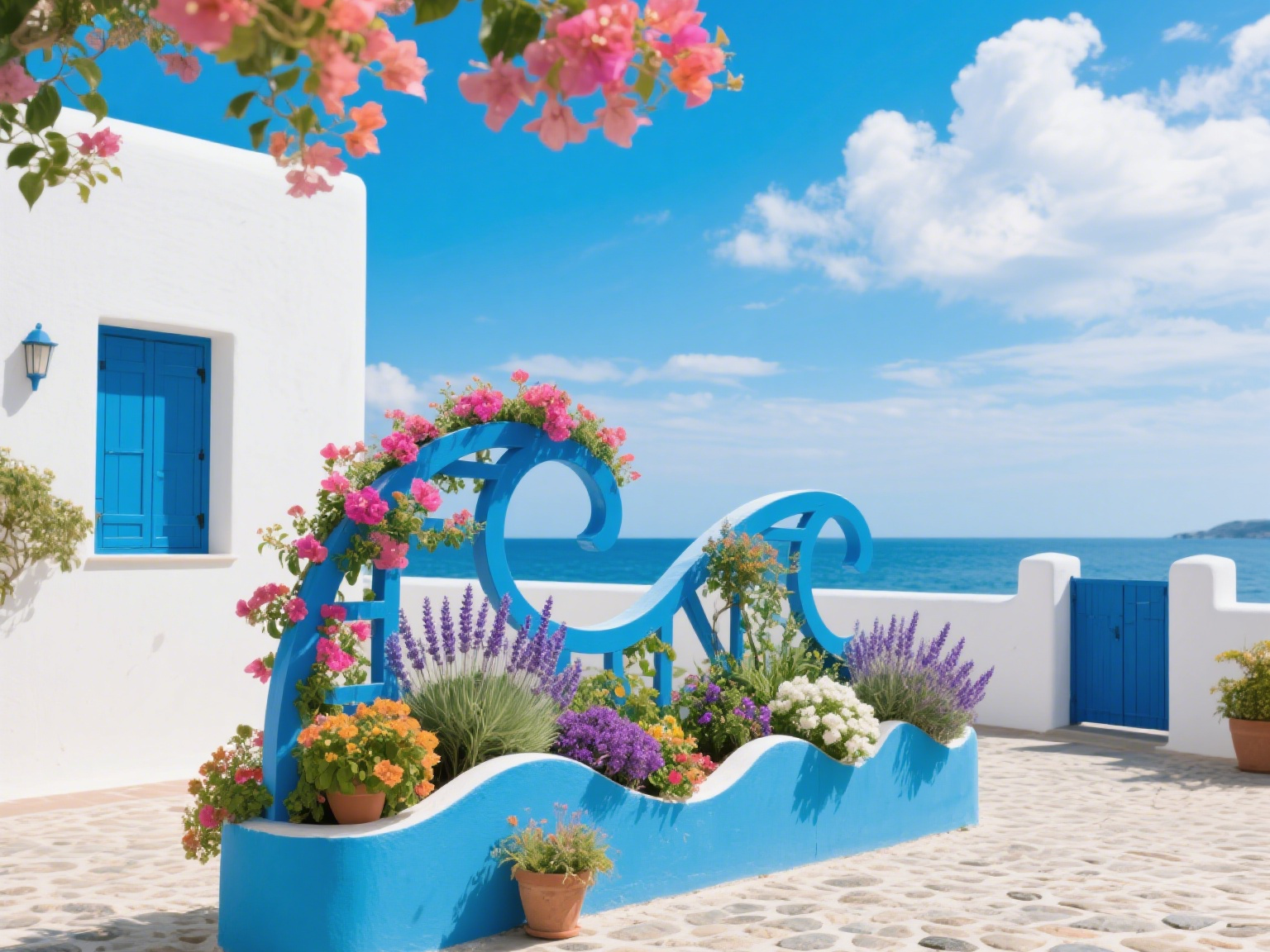In the window of an antique shop in Paris’ Marais district, a set of black PVC flower racks with geometric lines forms a unique silhouette, where turtleback plants on the shelves complement bronze candlesticks. Sunlight filters through the hollowed textures of the racks, weaving retro patterns on the ground, often making passersby stop and mistake them for art installations by some artist. This scene reveals the true value of PVC flower racks: they are not just plant containers but creators of spatial aesthetics, weaving poetic connections between nature and life through details.
1. Spatial Magic: Infinite Possibilities from Small Corners to Grand Scenes
On a 30㎡ balcony in Hong Kong, designers have integrated a foldable PVC flower rack into the wall. When unfolded, it resembles a butterfly spreading its wings: three tiers of shelves extend sequentially, with pothos vines cascading like curtains and succulent arrangements adding touches of green. This “invisible flower rack” serves as a green stage by day and transforms into wall decor by night, enabling small spaces to serve multiple purposes. Resident Ms. Chen jokes, “It’s like my secret garden, and opening it instantly cures the fatigue of the day.”
In the outdoor seating area of a café on Seoul’s Ar, several white PVC flower racks form a wavy landscape. The racks’ weathered surfaces exude a mottled texture, harmonizing with the old brick walls of the building. Each rack is equipped with an automatic drip irrigation system, planted with lavender and rosemary. As customers order, their fingertips brush against the leaves, releasing aromas that transport them to a Provençal manor. The café owner says, “This is more than just decoration; it’s an extension of a multi-sensory experience.”

2. Material Innovation: Reimagining the Warmth of “Plastic”
New-generation PVC flower racks break free from the stereotype of “cheapness”: those with rattan-woven textures offer a natural touch, creating a tropical rainforest ambiance in living room corners when paired with warm-toned lighting; racks with metallic coatings fit seamlessly into industrial-style offices, contrasting with steel beams while adding softness through greenery. A London design team has even created transparent flower racks from recycled ocean plastic bottles, embedding driftwood fragments in the shelves to make “environmental protection” a tangible aesthetic symbol.
Their durability is equally groundbreaking: at a desert hotel in Dubai, sand-resistant PVC flower racks stand firm by the outdoor pool, with nano-coatings on their surfaces allowing dust to be easily brushed off; in a high-rise apartment in Shanghai, cantilevered flower racks with aviation-grade aluminum alloy connectors remained stable during typhoon tests, serving as safe havens for high-altitude greenery.
3. Scenario Narratives: Emotional Connections Beyond Functionality
In a boutique clothing store in Tokyo’s Daikanyama district, flower racks act as “seasonal messengers”: shelves are filled with cherry blossom-themed potted plants in spring, replaced by mint and hydrangeas in summer, and adorned with red leaves and pine branches to evoke wabi-sabi in autumn and winter. Staff regularly host “flower rack dressing workshops,” inviting customers to participate in plant arrangement, turning shopping into a ritual of interaction with nature.
In a shared office space in Berlin, flower racks become “social catalysts”: small racks beside each workstation hang handwritten “plant name tags” with care tips and personal stories. Next to a pothos plant, one tag reads, “This cutting came from my hometown and has witnessed three of my moves.” These green plants with personal memories infuse warmth into the otherwise cold office environment.

4. The Art of Details: Minimalist Philosophy of Installation and Maintenance
Snap-fit installation makes DIY a breeze: Beijing white-collar Ms. Li assembled a flower rack on her own, reducing the “15-minute installation” in the instructions to just 8 minutes—no tools needed, just aligning the slots and pressing firmly to secure the shelves and columns. The magnetic bases of hanging racks are equally user-friendly, allowing renters to remove them by hand without leaving marks on walls when moving.
Maintenance is nearly “burden-free”: Taipei gardening blogger Akai shares, “Rinsing the rack with a showerhead once a month removes 90% of dust; for stubborn stains, a spray of neutral detergent and a quick scrub with a sponge do the trick.” For structural checks, simply tightening screws and inspecting snaps once a year keeps the rack in optimal condition.
5. Future Visions: When Flower Racks “Breathe”
At the Milan Furniture Fair, a “smart flower rack” sparked: equipped with sensors, it automatically adjusts shelf spacing based on plant growth—raising the upper shelf as roses grow taller and rotating the rack toward sunlight when succulents lack light. Even better, it sends APP reminders: “Your fiddle-leaf fig needs fertilizing!”
In environmental innovation, Amsterdam’s “edible flower rack” project uses degradable PVC shelves planted with strawberries, cherry tomatoes, and other vegetables. When the fruits ripen, the shelves trigger picking reminder lights. This closed-loop design from “planting to table” turns balconies into urban “micro-farms.”

6. Life Insights: The Emotional Projection Behind Greenery
New York designer Deborah writes in Nature in Home Décor, “Choosing a flower rack is essentially a statement about one’s lifestyle.” Some use flower racks to create “urban sanctuaries,” filling shelves with succulents from around the world, each recording a travel story; others practice “slow living” by watering mint every morning, watching water droplets fall from the shelves as a daily ritual.
In an old Tokyo neighborhood, a retired teacher has turned a flower rack into a “community exchange hub”: the lower tier grows shareable herbs for neighbors to pick; the middle tier holds unused gardening tools for swapping; the upper tier serves as a “plant observation corner” for children to record sunflower growth daily. This rack is not just a plant container but a warm community hub.
The true charm of PVC flower racks lies in their “moldability”—not in physical form but in their embrace of diverse lifestyles. They can be healing corners in single-person apartments, traffic magnets in commercial spaces, advocates of environmental principles, or testbeds for technological living. When we plant a seedling on a rack, we’re sowing a seed of hope for life—watching it grow is like witnessing our own journey of growth alongside our space. Perhaps this is the power of nature: it never seeks to change things deliberately, yet it subtly infuses every ordinary day with light. And PVC flower racks are the gentle carriers of this light.
